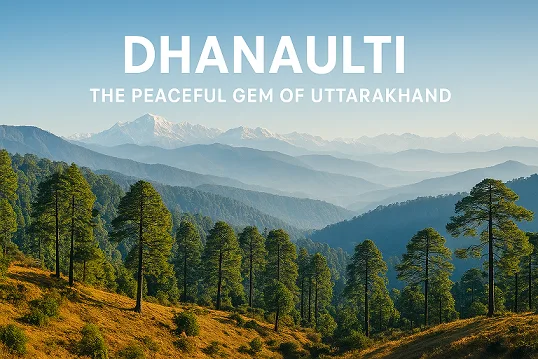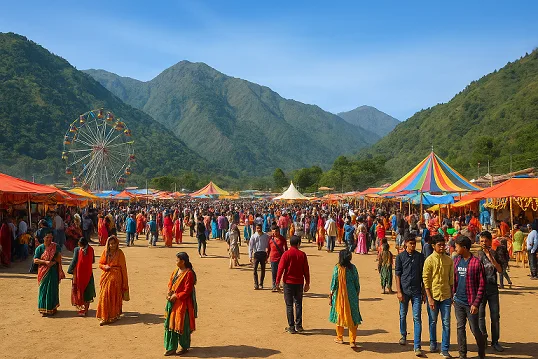How Tea Estates Developed in Darjeeling – A Detailed History

Mohit Bangari
Explore Himalaya With Me!!

Darjeeling, often called the “Queen of Hills”, is world-famous for its aromatic tea. The tea estates of Darjeeling produce one of the finest teas, known for its unique flavor and fragrance. But how did tea cultivation in Darjeeling start? The story goes back to the British colonial period, when experiments with tea plantations transformed Darjeeling into a global tea hub.
How Tea Came to Darjeeling
Before tea plantations, Darjeeling was a sparsely populated hill region. The British established Darjeeling as a hill station in the 1830s, mainly as a sanatorium for British officers. Around the same time, the British East India Company was looking for ways to break China’s monopoly on tea.
In 1835, the British East India Company took control of Darjeeling from the Raja of Sikkim. Seeing the potential of Darjeeling’s climate and altitude, Dr. Archibald Campbell, a British civil servant, started experimenting with tea plants in 1841. He planted Chinese tea saplings in his garden in Beechwood, Darjeeling. These experiments were successful, encouraging the British to expand tea cultivation.
Establishment of Tea Estates
The success of Campbell’s experiments led to the official introduction of tea plantations in Darjeeling. By the 1850s, the British government started giving land to planters, leading to the establishment of tea estates. The first commercial tea garden, Steinthal Tea Estate, was set up by the German missionary Father Joachim Stölke in 1852.
The British government also encouraged British planters to invest in tea cultivation. By 1866, there were already 39 tea gardens in Darjeeling, covering around 1,000 hectares of land. These estates were mostly run by British planters, who brought in Nepali laborers to work on the tea plantations.
Growth and Expansion of Tea Estates
The second half of the 19th century saw a boom in Darjeeling’s tea industry. More tea estates were developed, and tea production increased. Some of the oldest and most famous tea gardens established during this period include:
Makaibari Tea Estate (1859) – One of the oldest and most famous tea gardens.
Castleton Tea Estate (1885) – Known for its high-quality black tea.
Glenburn Tea Estate (1859) – A picturesque estate set up by Scottish planters.
The British introduced different varieties of tea bushes, including Camellia sinensis var. sinensis (Chinese variety) and Assam hybrids. The unique combination of Darjeeling’s high altitude (600–2,000 meters), cool climate, misty air, and well-drained soil gave its tea a distinctive muscatel flavor.
Role of Nepali Laborers in Tea Estates
One of the most important aspects of Darjeeling’s tea industry is the contribution of Nepali laborers. When the British started tea cultivation, they needed a large workforce. Since Darjeeling’s local population was small, the British brought in workers from Nepal. These hardworking laborers played a crucial role in shaping the tea estates. Even today, the majority of tea estate workers in Darjeeling are of Nepali origin.
Challenges Faced by Tea Estates
Despite its growth, the tea industry faced many challenges:
1. Labor Shortage – The workforce depended on Nepali migrants, and labor strikes sometimes affected tea production.
2. Market Competition – By the early 20th century, tea estates in Assam and Sri Lanka (Ceylon) started competing with Darjeeling tea.
3. World Wars and Independence – Both World War I & II disrupted tea trade, and after India’s independence in 1947, many British planters sold their tea estates to Indian owners.
4. Climate Change & Productivity Issues – In recent years, climate change has affected tea production, leading to lower yields and changing flavors.
Modern-Day Darjeeling Tea Estates
Today, Darjeeling has around 87 tea gardens, producing 8-10 million kg of tea annually. Some of the biggest names in the tea industry include:
Makaibari Tea Estate – Famous for organic tea.
Glenburn Tea Estate – A luxury tea estate and resort.
Happy Valley Tea Estate – One of the highest tea gardens in Darjeeling.
Darjeeling tea now enjoys Geographical Indication (GI) status, meaning only tea grown in this region can be called “Darjeeling Tea”. The Tea Board of India ensures quality control, and most tea estates focus on organic and sustainable farming.
Conclusion
The tea estates of Darjeeling have come a long way since the 19th century. What started as a small experiment by the British became a global brand. Today, Darjeeling tea remains one of the most prized teas in the world, known for its rich aroma and unique flavor. Despite challenges, the tea gardens continue to flourish, preserving the legacy of one of India’s finest beverages.
Article by – Mohit Bangari
Also read- History of IIT Roorkee – A Detailed Journey of India’s Oldest Engineering College
Related Post

Mohit Bangari
Explore Himalaya With Me!!







